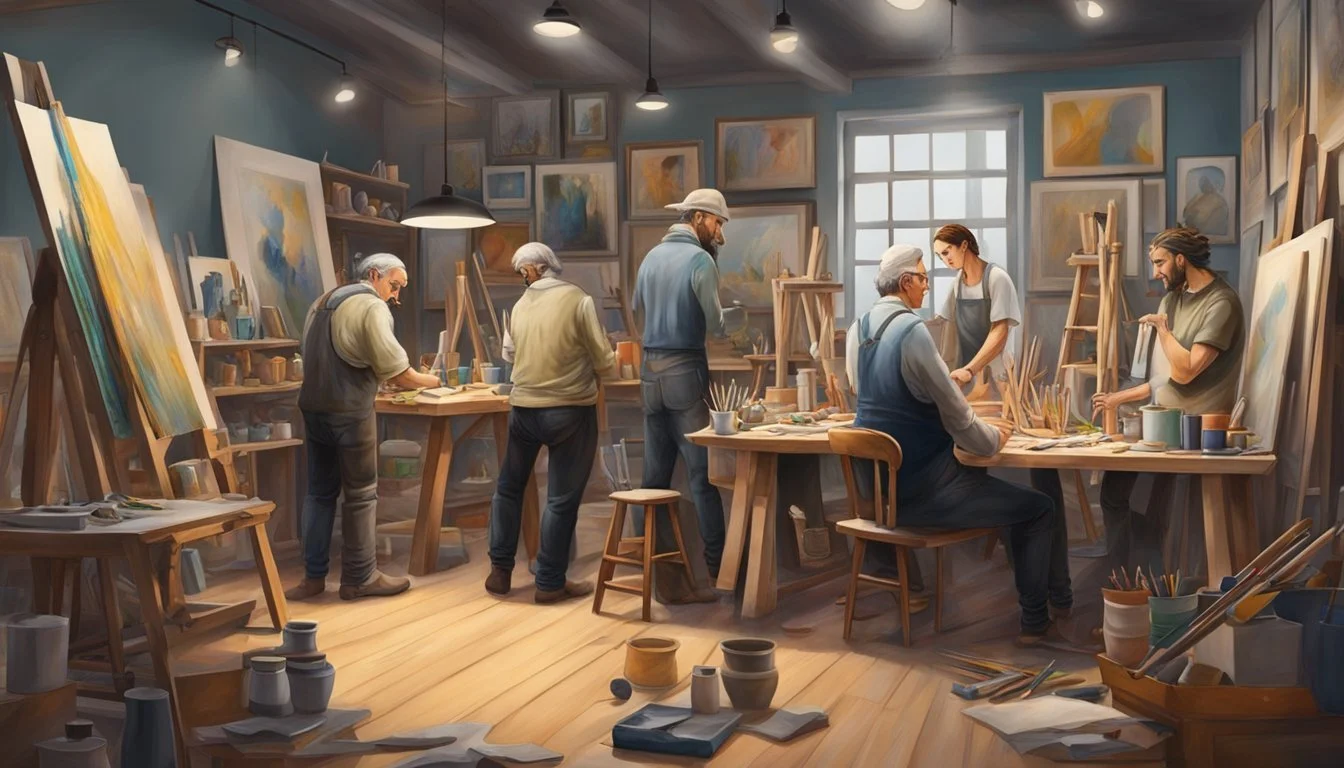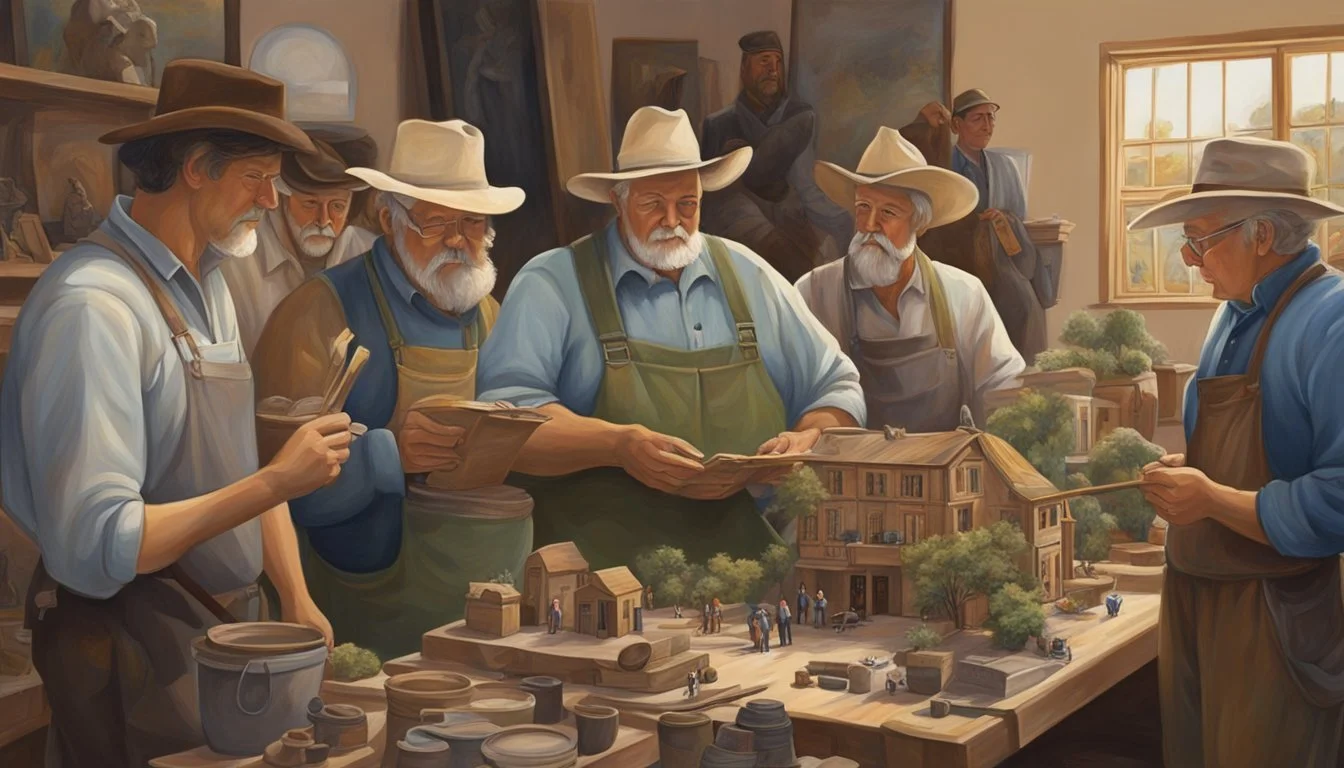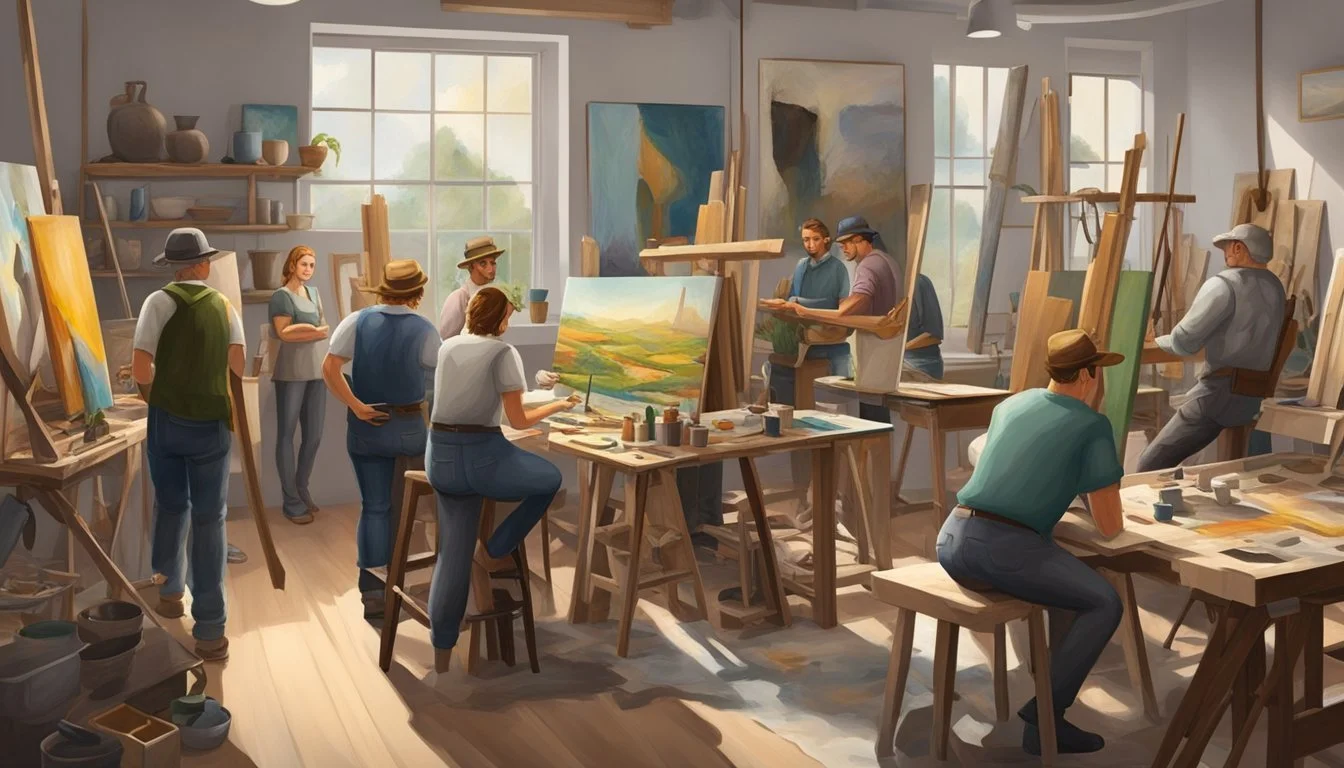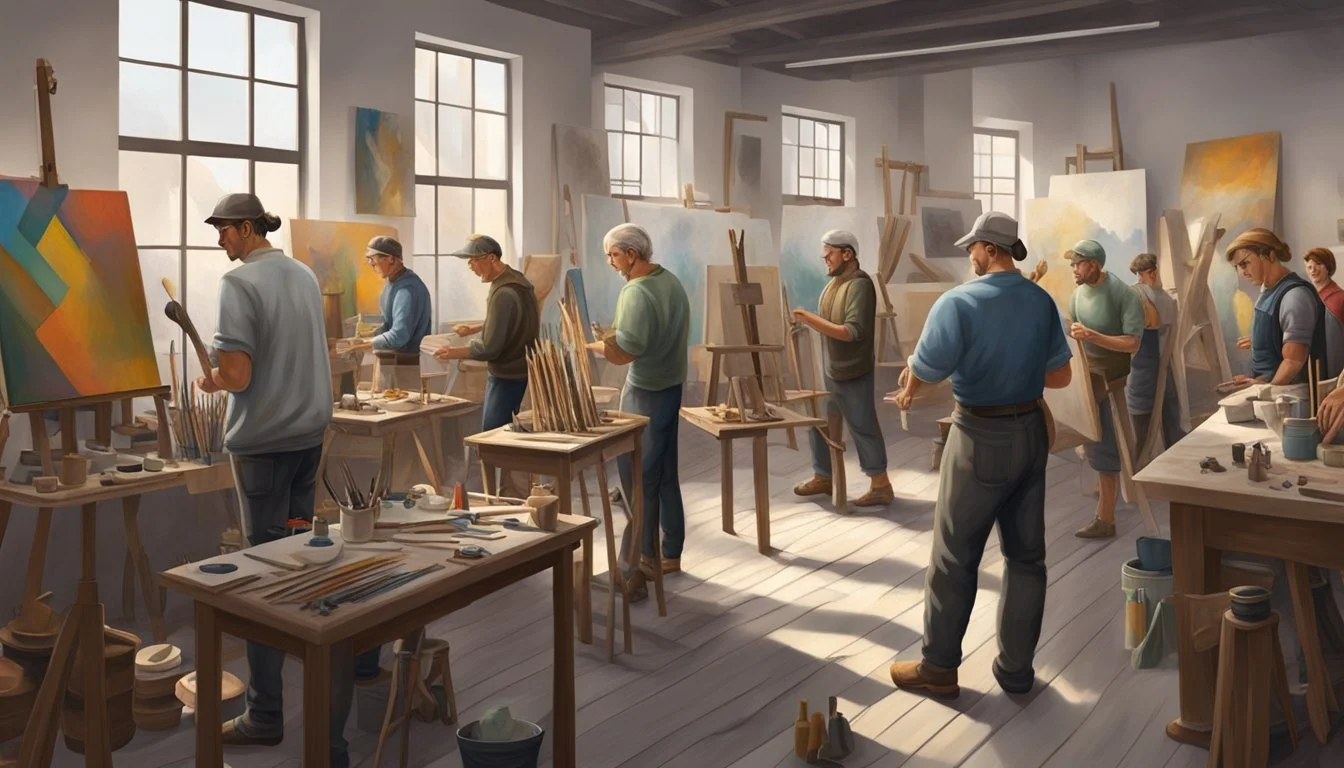The History of German Texan Painters and Sculptors
A Cultural Legacy Explored
The intersection of German heritage and Texan culture is a unique facet of the state’s diverse artistic landscape. The wave of German immigration to Texas in the 19th century brought with it a profound influence on the local art scene, introducing new perspectives and techniques that have since become a part of Texas's cultural tapestry. German Texans applied their European artistic roots to reflect their new environment, creating works that often captured the pioneering spirit of their adopted homeland while retaining ties to their Germanic past.
Artists of German descent in Texas have left their mark in various forms, but their contributions to painting and sculpture stand out for their distinct style and historical value. German Texan painters and sculptors often blended traditional German styles with the inspiration drawn from the Texan landscape and culture. This artistic amalgamation played a significant role in shaping the visual arts within the state, thus creating a legacy that is both rich in heritage and uniquely American.
Through sculpture and painting, German Texans crafted a narrative that offered a glimpse into their collective experience—encompassing the struggles of immigration, the challenges of frontier life, and the synthesis of German and Texan identities. The works produced by these artists not only add depth to the state's artistic history but also serve as a testament to the enduring influence of German culture in Texas.
Origins and Migration
German immigrants significantly influenced Texan culture and arts through their migration and settlement strategies during the 19th century. These immigrants not only founded towns and infused their culture into the Texan landscape but also brought their artistic traditions, enriching the local arts scene with painting and sculpture.
German Influence on Texan Culture
German settlers left a substantial imprint on Texan society, which still echoes in the state's culture today. New Braunfels, Boerne, Fredericksburg, and Comfort are some prominent examples of towns established by Germans in Texas. These towns became centers where German culture, language, and art could flourish. The impact was profound, ranging from culinary arts to architecture, and importantly to the visual arts such as painting and sculpture. Various German dialects still heard in these regions reflect the enduring presence of their heritage.
Adelsverein and Settlements
The Society for the Protection of German Immigrants in Texas, commonly known as the Adelsverein, was instrumental in organizing German migration to Texas. Established by a group of 21 noblemen in 1842, the Adelsverein played a key role in charting the new settlements, with a commissioner often being appointed to oversee the logistics of migration and settlements such as New Braunfels founded in 1845.
Adelsverein: Established 1842 by German nobility.
Commissioner: Appointed for settlement oversight.
New Braunfels: Founded 1845, a notable German settlement by the Adelsverein.
Protection and Assimilation
The Adelsverein not only facilitated the migration and settlement of German immigrants but also provided a measure of protection as they assimilated into United States society. Protestant Germans found themselves mingling with the predominantly Latin Catholic population of Texas, thus creating a diverse cultural tapestry in which German artists could express themselves. The success of these colonies helped maintain a sense of identity while also allowing Germans to contribute to the broader Texan culture.
Artistic Developments in Texas
In the rich tapestry of Texas history, German Texan artists have contributed significantly to the state's artistic heritage. This section will explore how these artisans' skills in sculpture, painting, and their cultural influence have shaped the visual landscape of Texas.
Sculpture and Woodcarving
German Texan sculptors brought with them a strong tradition of stone carving and woodcarving, skills that had been honed in the forests and quarries of Germany. They found abundant materials in Texas, like local limestone, and adapted their techniques to the natural landscape. This was reflected in intricately-carved furniture, gravestones, and architectural details that became hallmarks of German-Texan communities.
Materials: Indigenous stone, wood
Notable Techniques:
Relief carving
Figurative sculpture
Painting Techniques
As for painting, German Texans exhibited mastery in both the materials they used and the perspectives they brought to their canvases. They often utilized oil paints to capture the local environment and were pioneers in portraying the vast Texas landscape with European sensibilities. Their work provided a blending of the Old World with the new, often incorporating elements of German culture into their depiction of the Texan panorama.
Key Elements:
Emphasis on natural light
Detailed texture representation
Cultural Exchange and Transformation
The intermingling of German artistic traditions with Texan culture led to a unique transformation in the local art scene. German Texan artisans did not exist in isolation; they shared their techniques and borrowed from the local traditions, influencing the Texan art culture and, in turn, being influenced by it. This cultural exchange broadened the scope of both groups' artistic visions, resulting in a distinct legacy that tells a shared story of diversity and adaptation.
Cultural Influences: German and Texan traditions
Resulting Transformations: Evolution of shared artistic styles
Influential Figures
The history of German Texan painters and sculptors is marked by the contributions of notable European artists whose legacies have transcended time and geography. Among these, Tilman Riemenschneider and Hans Holbein stand out for their distinctive styles and lasting impact on art.
Tilman Riemenschneider
He was an eminent sculptor and woodcarver active in Würzburg during the late Gothic period. Born around 1460, Riemenschneider's prominence rose as he became master of his own workshop. Notable for his figures' expressive faces and intricate drapery, he was especially renowned for his religious works. Riemenschneider's notable pieces include:
Altarpieces: Profoundly crafted for churches in Germany, like the famous Holy Blood altarpiece in Rothenburg ob der Tauber.
Sculptures of Mary: His representations were known for their grace and intricate detail, often regarded as pinnacles of his career.
Hans Holbein
Hans Holbein the Younger, born in Augsburg, emerged as a distinguished painter in the early sixteenth century. Working mainly in Basel and later in London, Holbein became known for his precision and use of color. His expertise extended not only to portraiture but also to religious scenes, with a keen eye for both composition and human psychology. Holbein's significant works include:
Portraiture: Masterpieces that captured the essence of his subjects, including the nobility and intellectuals of his era.
Religious Works: Though less noted than his portraiture, his biblical scenes conveyed a deep understanding of narrative and character.
Both artists significantly influenced the visual arts, with their techniques and masterpieces continuing to be studied and revered in contemporary times.
Historical Context and Contributions
German Texan painters and sculptors contributed to the rich tapestry of the state's cultural heritage, reflecting religious themes and the melding of European artistic sensibilities within their work.
Religious Influences
German Texan artwork of the 19th century often exhibited a strong Protestant ethic, a legacy of the Reformation that swept across Central Europe. The impact of these religious shifts was evident in the focus on private devotion and the adaptation of Christian themes in art. Mainz, one of the pivotal sites of the Reformation, influenced the religious overtones seen in many pieces of German Texan art.
European Artistic Traditions
German artisans in Texas were profoundly influenced by the cultural history of Germany and Central Europe. They brought with them traditions from the Netherlands, France, and Italy, manifesting in a unique style that stood distinct from their American counterparts. Artistic contributions reflect a synthesis of European styles, with notable influences from German masters such as Marc, and the broader artistic movements that flowed through cultural hubs like Vienna and Poland. These influences gave rise to a distinctive art that, while reflective of European roots, was distinctly Texan in its expression.
Legacy and Preservation
The rich tapestry of German Texan painters and sculptors continues to resonate today, with a focus on the careful preservation of their work and its influence on the contemporaneous art scene.
Collections and Exhibitions
Museums and private collections across Central Texas hold a wealth of artwork from German Texan artists. The Handbook of Texas Online and Wikipedia serve as repositories of information on these artists, providing a virtual showcase of their biographies and works.
Preservation: Notable museums actively collect and preserve the legacy of these artists to ensure that their influence endures. Key pieces are often on display in exhibitions, offering the public a glimpse into the past.
Exhibitions: These works feature regularly in exhibitions, both in local historical museums and in traveling showcases, often aiming to educate viewers on the peace and prosperity that marked the post-treaty era in Central Texas.
Modern-Day Influence
German Texan painters and sculptors have left an indelible mark on the artistic landscape of Texas.
Cultural Impact: Their distinctive styles and craftsmanship continue to influence modern artists in the region, with echoes of their impact seen in contemporary artistic endeavors.
Tangible Legacy: The presence of German Texan art in public spaces, as well as the ongoing study and appreciation in academic circles, ensures that their contributions to Texan culture are not only preserved but celebrated.
Contemporary German Texan Artists
Contemporary German Texan artists blend the rich heritage of German culture with the vibrant, diverse influences of Texas's regional art scene. They maintain a confident presence in the modern art world, consistently contributing to the cultural tapestry of the Texas Hill Country and beyond. The intersection of these identities lends a unique perspective to their artistic expression.
Painters from this niche often incorporate elements of the sprawling Texan landscapes and German artistic traditions in their work. Artists honor their German roots while also embracing the Texan spirit, refining techniques that traverse the boundaries of classical and contemporary styles.
Sculptors, on the other hand, might use local materials, drawing inspiration from the Hill Country's natural beauty. They craft pieces that engage with the space and history, seamlessly integrating German precision with Texan boldness.
Notable entities in this community include:
Art Institutes and Collectives: Serving as pivotal platforms, they foster growth amongst emerging artists and facilitate the fusion of German and Texan artistic disciplines.
Exhibitions and Art Shows: These venues heighten awareness and appreciation of the unique blend of cultures within the modern art sphere, often spotlighting German Texan artists.
In essence, these artists contribute to the evolving narrative of Texas's rich artistic legacy. Their work encapsulates the enduring spirit of German craftsmanship married to the rugged and diverse essence of Texas's cultural landscape. Without a doubt, their continued production and innovation maintain the dynamism that is emblematic of contemporary German Texan art.
Conclusion
The synthesis of German immigrant culture with Texan influences has culminated in a unique artistic legacy, particularly evident in painting and sculpture. German Texans' contributions to the arts have echoed through the corridors of Texas history, firmly establishing their impact on the state's cultural tapestry.
Painters of German descent in Texas assimilated and adapted their ancestral techniques to the Texas landscapes. They provided fresh perspectives on the region's aesthetics, infusing their European roots with Texan motifs. Their landscapes and portraits offer a narrative that is deeply rooted in the complexities of immigration and cultural amalgamation.
The craftsmanship of German Texan sculptors, characterized by their skillful techniques, reveals the integration of traditional German methods with the resources and inspirations found in Texas. Their work has been an important part of the state’s artistic evolution, merging old-world expertise with new-world experiences.
In summary, the artistic endeavors of German Texans have repeatedly showcased a harmonious blend of heritage and adaptation, leaving an indelible mark on the state's history. This influence has both preserved and enriched the German Texan identity, ensuring their legacy is recognized and appreciated.
Key Entity Influence on Texan Art German Texans Significant German Immigrants Foundational Legacy Enduring Influence Pervasive
Their influence will continue to be admired and studied by art enthusiasts and historians alike, as a testament to the enduring nature of cultural integration and its impact on artistic expression.
References
Gothic and Renaissance Art in Nuremberg: This period marked a significant influence on German Texan artists with roots traced back to Nuremberg, renowned for its artistic flowering during the Gothic and Renaissance eras.
Limewood Sculptors of Renaissance Germany: They provided inspiration to German Texan sculptors. The limewood medium was favored for its fine grain and workability, crucial for intricate details favored in Renaissance Germany.
Period Influence Late Middle Ages Riemenschneider's work impacted German Texan sculptors. Early Valois Courts The patronage model influenced how artists secured commissions. Later Valois Courts Continuation of patronage shaped art in German Texan communities.
Tilman Riemenschneider: Master Sculptor of the Late Middle Ages: His contributions as a master sculptor were baked into the foundation of German Texan sculptural practices. Techniques and style echo in the aesthetic choices of local Texas-based artists.
Materials and Techniques: Artists frequently employed traditional European techniques, adapting to local Texan materials while preserving the Germanic essence in their work.
Patronage: Inspired by historical models, such as those at the Valois courts, the patronage system was reflected in how German Texan artists received support and commissions.
Images for the Cult and for Private Devotion: Religious and personal artworks created for devotion carried on the rich tradition of German religious art, effectively blending this practice with Texan cultural motifs.
Polychromy and Monochromy: The use of various color palettes, including both polychrome and monochrome, are a testament to the diverse techniques brought forth by German Texan painters and sculptors.
Further Reading
Books:
"The Material Culture of German Texans" by Kenneth Hafertepe
A comprehensive survey focusing on the art and artifacts of German Texans that provides insight into their cultural inheritance and its evolution over time."History of the German element in Texas from 1820-1850"
An in-depth look at the early German migration, their settlements, and how this period forged the identity of German Texans, including their contributions to arts.
Journals and Articles:
German Texas Heritage Society's publications
These periodicals often include studies and articles on German Texan artists and their works. They provide a scholarly overview of German influences in local art.
Museums and Galleries:
Gillespie County Historical Society (Pioneer Museum)
This museum often showcases works of local German Texan artists and sculptors within their historical context.The Sophienburg Museum & Archives
Offers exhibits and collections significant to the New Braunfels area, founded by German immigrants, with occasional highlights on artistic contributions.
Online Resources:
Texas Historical Association Online
Its digital encyclopedia may contain references and entries related to key German Texan painters and sculptors.Handbook of Texas Online
A searchable resource that provides biographies and cultural insights into the influential figures of Texas history, including German Texan artists.
Researchers and enthusiasts should consider visiting these resources for more comprehensive information on the history of German Texan painters and sculptors. Visiting local historical societies and university libraries could also unveil more specialized texts and undocumented works of art.











